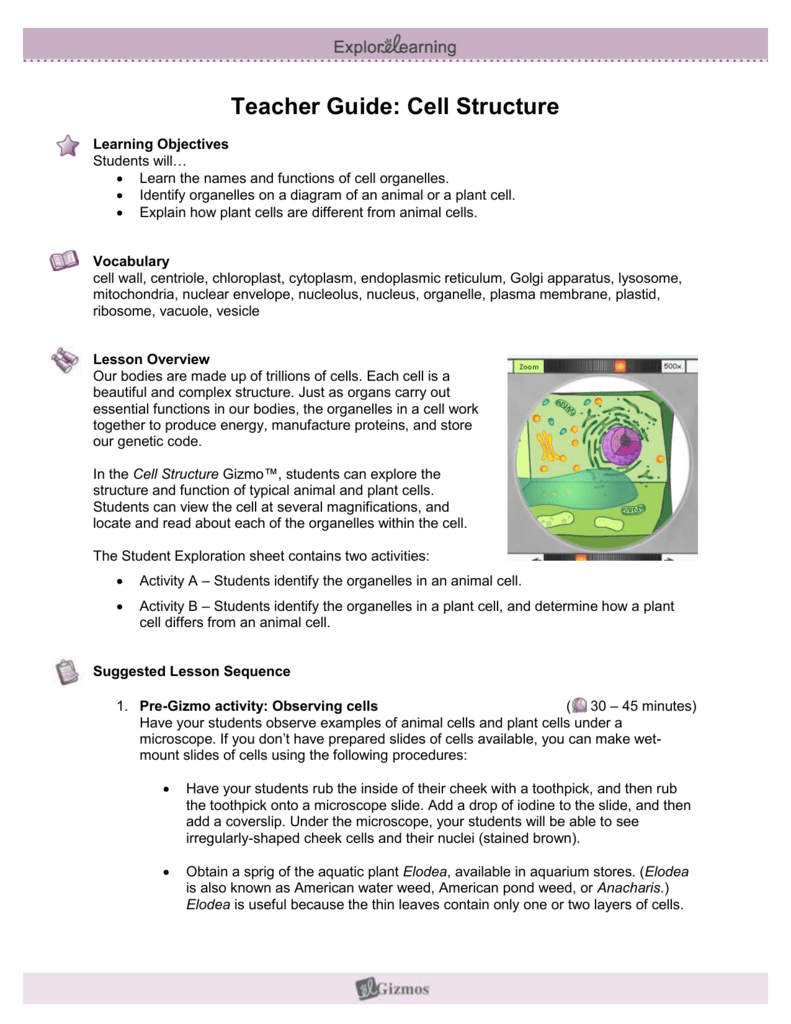Imagine peering into the very foundation of life, a bustling city teeming with activity, but instead of concrete and steel, you find intricate molecular machinery and life-sustaining processes. This microscopic world, the cell, is the building block of all living organisms, from the smallest bacteria to the tallest redwood tree. Embark on a captivating journey with us as we explore the intricate world of cell structure, unraveling its mysteries with the help of engaging Gizmos, interactive simulations designed to make learning a thrilling adventure.

Image: gustavogargiulo.com
Stepping into the world of cell biology can feel like entering a foreign land full of complex terminology and perplexing diagrams. But with the aid of Gizmos, we can transform this learning experience into an interactive and engaging exploration. Gizmos allow you to manipulate virtual models of cells, zoom in on their components, and even experiment with their functions – making the abstract concepts come alive in a way that textbooks simply cannot replicate.
A Deeper Dive into the Cell Structure
The cell, the fundamental unit of life, is a complex and self-sufficient entity capable of carrying out all the essential functions necessary for survival. Understanding its structure is akin to deciphering the blueprint of life, revealing the intricate workings of its various components.
The Cell Membrane: A Dynamic Gatekeeper
The cell membrane, a thin, flexible layer, acts as a protective barrier, controlling the flow of substances in and out of the cell. It’s a dynamic structure, constantly adjusting to maintain the cell’s internal environment – a delicate balance essential for its survival. Think of it like a busy airport, where every molecule entering or leaving the cell undergoes a rigorous security check.
The Nucleus: The Cell’s Command Center
Imagine a cell as a bustling city, the nucleus serves as its central control room. It contains the genetic material, DNA, which holds the blueprints for all the cell’s activities, dictating everything from protein synthesis to cell division. As a safeguard, the nucleus is enclosed within a double membrane, ensuring the integrity of the genetic information.

Image: gustavogargiulo.com
Mitochondria: The Powerhouse of the Cell
Every cell needs energy to function, and the mitochondria are the powerhouses responsible for producing this vital energy currency, ATP. Imagine the mitochondria as tiny power plants within the cell, constantly breaking down nutrients and converting their energy into a form that the cell can use.
Ribosomes: The Cell’s Protein Factories
Proteins, the workhorses of the cell, are responsible for countless biological processes, from structural support to catalyzing reactions. Ribosomes, the manufacturing units of the cell, are responsible for assembling proteins based on the instructions encoded in DNA.
Endoplasmic Reticulum: A Complex Network of Interconnected Membranes
Imagine a vast network of interconnected tunnels within the cell, this is the endoplasmic reticulum (ER), playing a vital role in protein synthesis and lipid metabolism. The ER can be considered the cell’s highway system, transporting molecules between various organelles.
Golgi Apparatus: The Cell’s Packaging and Shipping Center
Think of the Golgi apparatus as the cell’s sophisticated post office, where proteins synthesized by the ER are modified, sorted, and packaged for delivery to their specific destinations within the cell, or even outside of it.
Lysosomes: The Cell’s Recycling Center
Lysosomes, the cell’s waste disposal system, are responsible for breaking down cellular debris, worn-out organelles, and engulfed bacteria. These recycling centers play a crucial role in maintaining the cell’s health.
Cytoskeleton: The Cell’s Structural Support System
Just like a skeleton provides support and structure for our bodies, the cytoskeleton gives the cell its shape and allows it to move and change. This intricate network of protein filaments helps to organize the cell’s contents, transport materials, and even facilitate cell division.
Exploring Cell Structure with Gizmos: A Virtual Journey of Discovery
The beauty of Gizmos lies in their ability to transform learning from a passive activity into an interactive experience. Imagine holding a virtual model of a cell in your hand, zooming in on its individual organelles, and even manipulating their functions – this is the power of Gizmos.
Interactive Simulations: A Gateway to Understanding
Gizmos offer a unique blend of visual and interactive learning. They allow students to experiment with different variables, observe the consequences, and develop a deeper understanding of the complex processes happening within the cell. Imagine testing the effects of different environments on the cell membrane – how do changes in temperature or pH affect the permeability of the membrane?
Virtual Laboratories: Bringing Science to Life
Imagine conducting experiments in a virtual laboratory, free from the constraints of real-world limitations. Gizmos provide a safe and engaging environment for testing hypotheses, observing results, and developing scientific thinking skills.
Teacher Resources: Enhancing Learning
Gizmos offer a treasure trove of resources for teachers, including interactive simulations, guided explorations, and assessments. This comprehensive suite of tools empowers educators to tailor their teaching approach to meet the unique needs of their students.
Unlocking the Secrets of Life: Gizmos as Tools for Exploration
The world of cell biology holds a universe of fascinating insights, and Gizmos are powerful tools that help students navigate this intricate landscape. By providing interactive experiences that bring abstract concepts to life, Gizmos empower learners to discover, explore, and grasp the fundamental building blocks of life.
From Microscopic Wonders to Life’s Grand Design
Understanding cell structure is not just about memorizing names and functions, it’s about appreciating the intricate interplay between the various components that create the symphony of life. Gizmos serve as a gateway to this fascinating world, allowing us to explore the microscopic wonders that underpin life.
Building a Foundation for Future Discoveries
Cell biology is a dynamic field, constantly evolving as scientists uncover new insights into the intricate workings of life. By immersing themselves in these interactive explorations with Gizmos, students develop a strong foundation that will serve them well as they embark on their own scientific journeys.
Gizmo Student Exploration Cell Structure Answer Key
Taking the First Step: Embracing Interactive Learning
The beauty of Gizmos lies in their accessibility. Whether you’re a student eager to delve into the world of cell structure or a teacher looking for engaging tools, Gizmos open a world of interactive learning opportunities. Embrace the power of visual learning, explore the fascinating intricacies of the cell, and unlock the secrets of life. The world of cell biology awaits, and with Gizmos as your guide, the journey promises to be both exciting and illuminating.
Remember: The key to unlocking the secrets of life lies not only in understanding the parts of the cell but in appreciating their interconnectedness and the intricate dance of molecules that brings life to this tiny world. Gizmos provide a unique platform for this journey of discovery, transforming passive learning into an active, engaging, and enriching experience.





